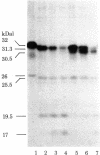Abstract
Mild trypsin treatment of Spirodela oligorrhiza thylakoid membranes leads to partial digestion of the rapidly metabolized, surface-exposed, 32,000-dalton protein. Under these conditions, photoreduction of ferricyanide becomes insensitive to diuron [3-(3,4-dichlorophenyl)-1,1-dimethylurea], an inhibitor of photosystem II electron transport. Preincubation of thylakoids with diuron leads to a conformational change in the 32,000-dalton protein, modifying its trypsin digestion and preventing expression of diuron insensitivity. Finally, light affects the susceptibility of the 32,000-dalton protein to digestion by trypsin. In other experiments, thylakoids specifically depleted in the 32,000-dalton protein were found to be deficient in electron transport at the reducing side of photosystem II but not at the oxidizing side or in photosystem I activities. Thus, the rapidly metabolized 32,000-dalton thylakoid protein in Spirodela chloroplasts fulfills the requirements of the hypothesized "proteinaceous shield" [Renger, G. (1976) Biochim. Biophys. Acta 440, 287-300] regulating electron flow through photosystem II and mediating diuron sensitivity.
Full text
PDF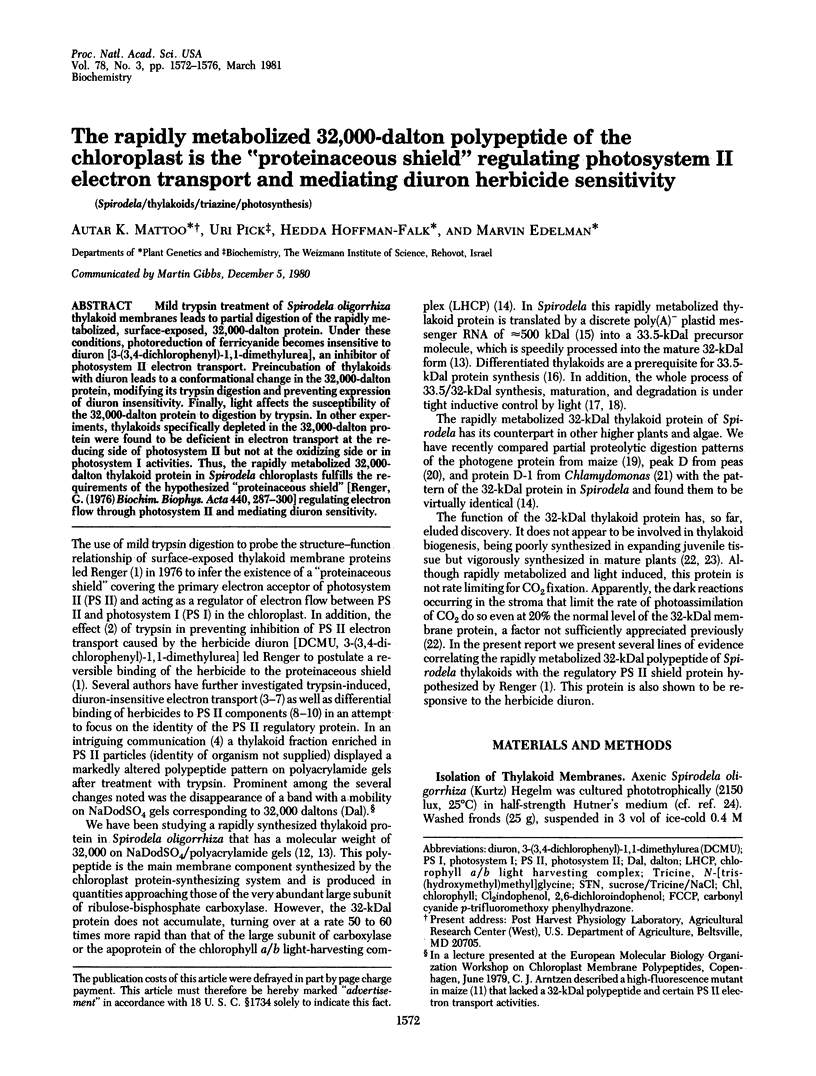
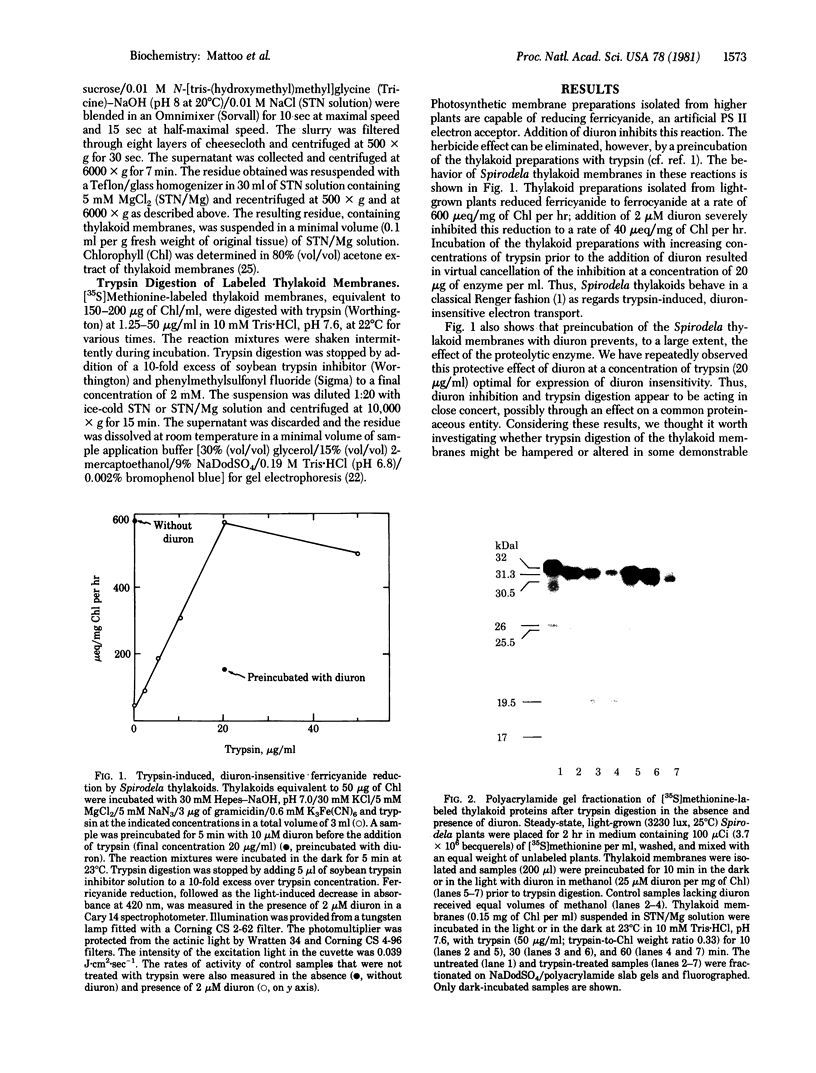
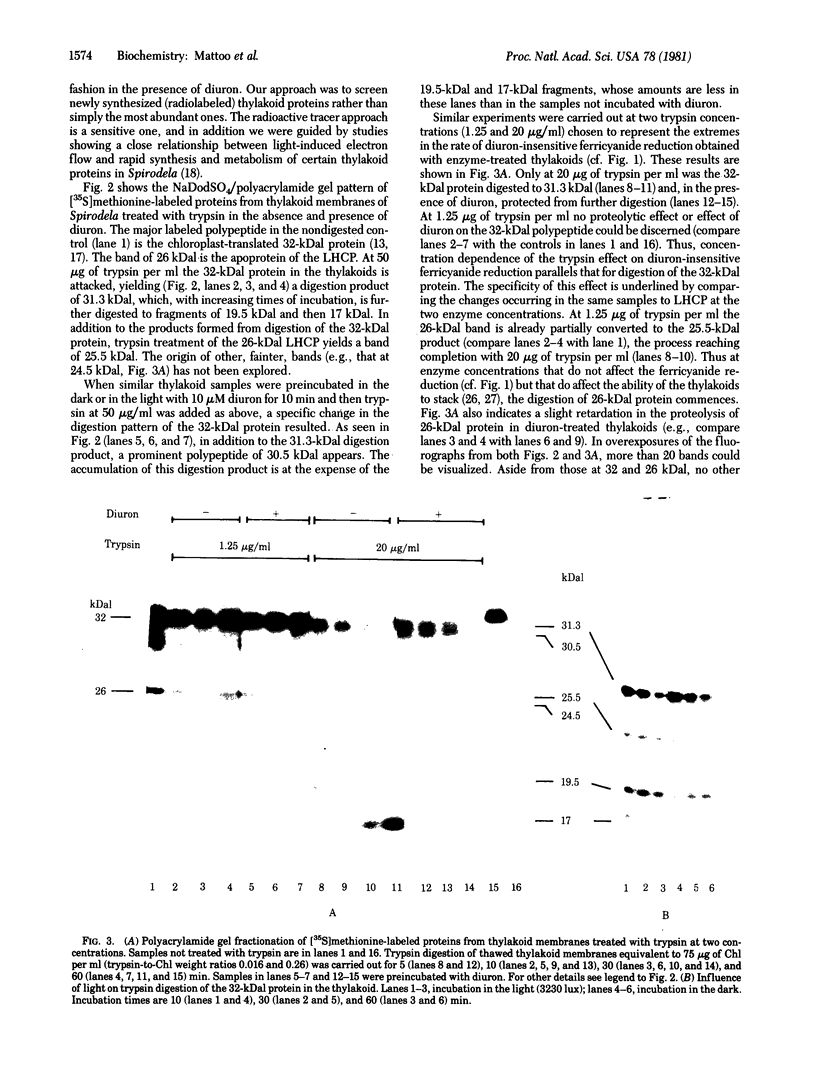
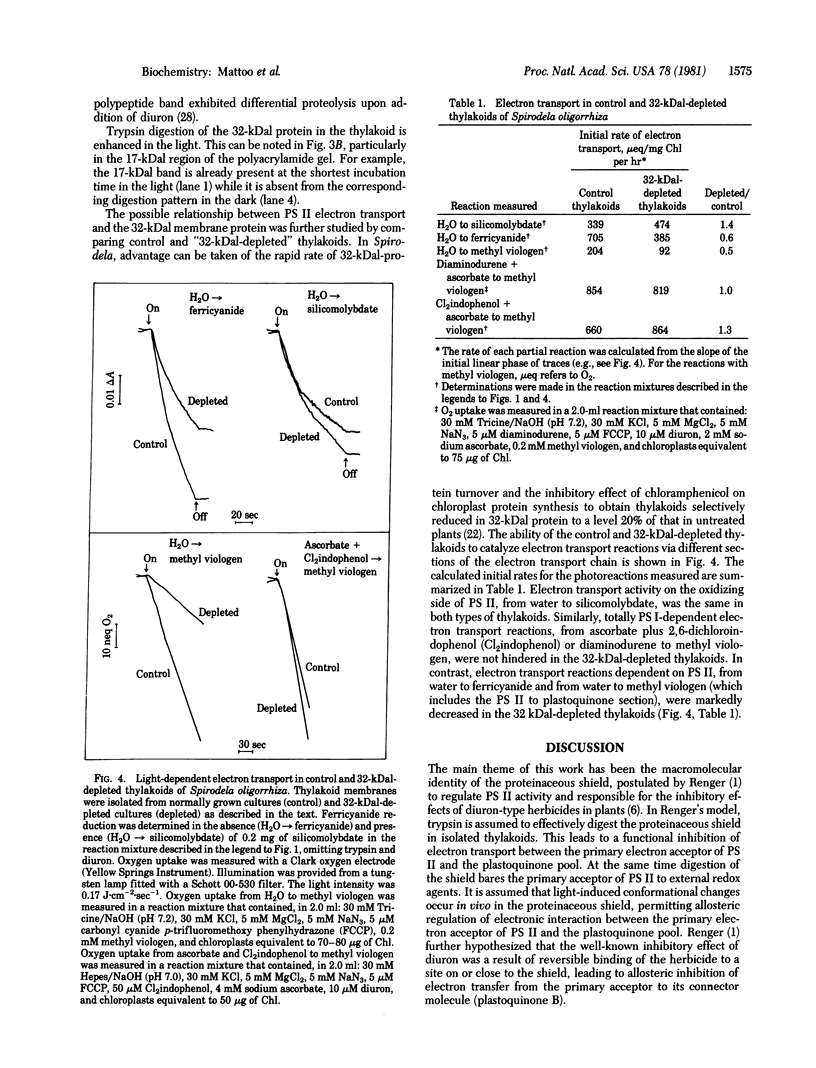
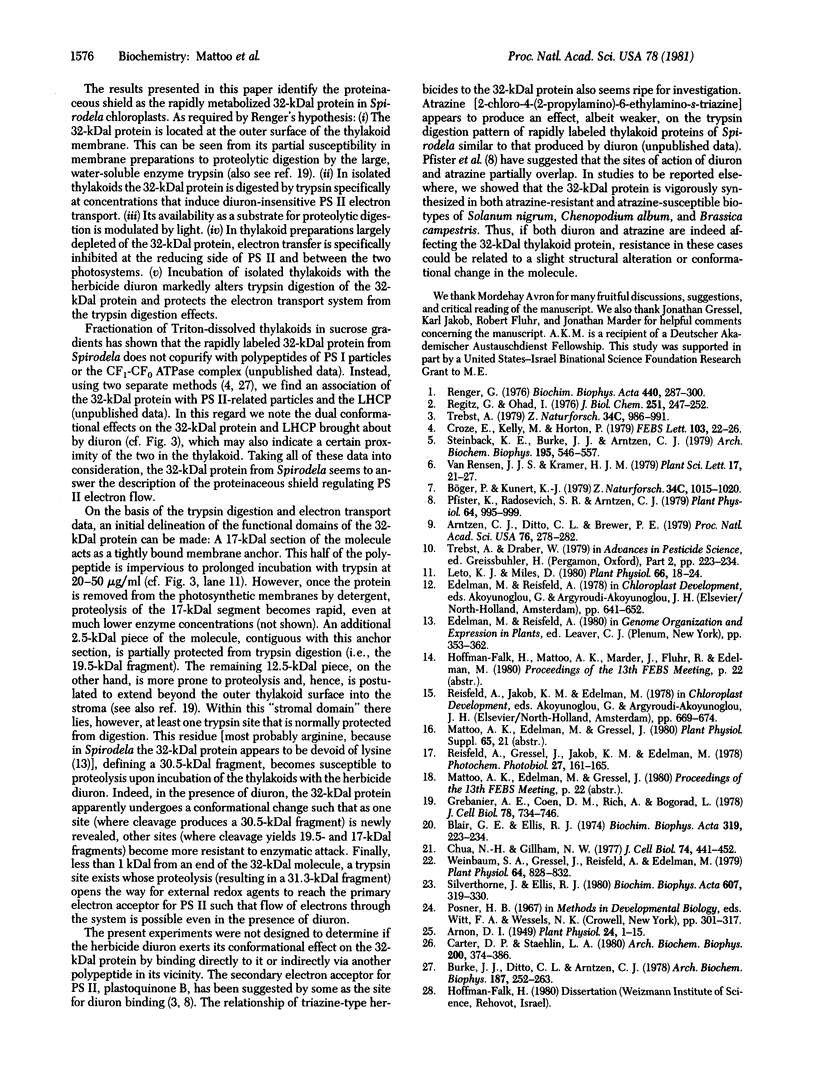
Images in this article
Selected References
These references are in PubMed. This may not be the complete list of references from this article.
- Arnon D. I. COPPER ENZYMES IN ISOLATED CHLOROPLASTS. POLYPHENOLOXIDASE IN BETA VULGARIS. Plant Physiol. 1949 Jan;24(1):1–15. doi: 10.1104/pp.24.1.1. [DOI] [PMC free article] [PubMed] [Google Scholar]
- Arntzen C. J., Ditto C. L., Brewer P. E. Chloroplast membrane alterations in triazine-resistant Amaranthus retroflexus biotypes. Proc Natl Acad Sci U S A. 1979 Jan;76(1):278–282. doi: 10.1073/pnas.76.1.278. [DOI] [PMC free article] [PubMed] [Google Scholar]
- Blair G. E., Ellis R. J. Protein synthesis in chloroplasts. I. Light-driven synthesis of the large subunit of fraction I protein by isolated pea chloroplasts. Biochim Biophys Acta. 1973 Aug 24;319(2):223–234. doi: 10.1016/0005-2787(73)90013-0. [DOI] [PubMed] [Google Scholar]
- Burke J. J., Ditto C. L., Arntzen C. J. Involvement of the light-harvesting complex in cation regulation of excitation energy distribution in chloroplasts. Arch Biochem Biophys. 1978 Apr 15;187(1):252–263. doi: 10.1016/0003-9861(78)90031-0. [DOI] [PubMed] [Google Scholar]
- Carter D. P., Staehelin L. A. Proteolysis of chloroplast thylakoid membranes. II. Evidence for the involvement of the light-harvesting chlorophyll a/b-protein complex in thylakoid stacking and for effects of magnesium ions on photosystem II-light-harvesting complex aggregates in the absence of membrane stacking. Arch Biochem Biophys. 1980 Apr 1;200(2):374–386. doi: 10.1016/0003-9861(80)90367-7. [DOI] [PubMed] [Google Scholar]
- Chua N. H., Gillham N. W. The sites of synthesis of the principal thylakoid membrane polypeptides in Chlamydomonas reinhardtii. J Cell Biol. 1977 Aug;74(2):441–452. doi: 10.1083/jcb.74.2.441. [DOI] [PMC free article] [PubMed] [Google Scholar]
- Croze E., Kelly M., Horton P. Loss of sensitivity to diuron after trypsin digestion of chloroplast photosystem II particles. FEBS Lett. 1979 Jul 1;103(1):22–26. doi: 10.1016/0014-5793(79)81242-9. [DOI] [PubMed] [Google Scholar]
- Grebanier A. E., Coen D. M., Rich A., Bogorad L. Membrane proteins synthesized but not processed by isolated maize chloroplasts. J Cell Biol. 1978 Sep;78(3):734–746. doi: 10.1083/jcb.78.3.734. [DOI] [PMC free article] [PubMed] [Google Scholar]
- Leto K. J., Miles D. Characterization of Three Photosystem II Mutants in Zea mays L. Lacking a 32,000 Dalton Lamellar Polypeptide. Plant Physiol. 1980 Jul;66(1):18–24. doi: 10.1104/pp.66.1.18. [DOI] [PMC free article] [PubMed] [Google Scholar]
- Pfister K., Radosevich S. R., Arntzen C. J. Modification of Herbicide Binding to Photosystem II in Two Biotypes of Senecio vulgaris L. Plant Physiol. 1979 Dec;64(6):995–999. doi: 10.1104/pp.64.6.995. [DOI] [PMC free article] [PubMed] [Google Scholar]
- Regitz G., Ohad I. Trypsin-sensitive photosynthetic activities in chloroplast membranes from Chlamydomonas reinhardi, y-1. J Biol Chem. 1976 Jan 10;251(1):247–252. [PubMed] [Google Scholar]
- Renger G. Studies on the structural and functional organization of system II of photosynthesis. The use of trypsin as a structurally selective inhibitor at the outer surface of the thylakoid membrane. Biochim Biophys Acta. 1976 Aug 13;440(2):287–300. doi: 10.1016/0005-2728(76)90063-3. [DOI] [PubMed] [Google Scholar]
- Silverthorne J., Ellis R. J. Protein synthesis in chloroplasts. VIII. Differential synthesis of chloroplast proteins during spinach leaf development. Biochim Biophys Acta. 1980 Apr 30;607(2):319–330. doi: 10.1016/0005-2787(80)90084-2. [DOI] [PubMed] [Google Scholar]
- Steinback K. E., Burke J. J., Arntzen C. J. Evidence for the role of surface-exposed segments of the light-harvesting complex in cation-mediated control of chloroplast structure and function. Arch Biochem Biophys. 1979 Jul;195(2):546–557. doi: 10.1016/0003-9861(79)90381-3. [DOI] [PubMed] [Google Scholar]
- Weinbaum S. A., Gressel J., Reisfeld A., Edelman M. Characterization of the 32,000 Dalton Chloroplast Membrane Protein: III. Probing Its Biological Function in Spirodela. Plant Physiol. 1979 Nov;64(5):828–832. doi: 10.1104/pp.64.5.828. [DOI] [PMC free article] [PubMed] [Google Scholar]



